#mountain cattlemen
Text

Fry's Hut, Howqua Hills, taken 1960's,
sourced: Mountain Cattlemen Association of Victoria
10 notes
·
View notes
Text
Barkback Mountain By The MeatMunchr
Authors notes:
3.3k words, one shot, FTM MLM
This is basically my “If Brokeback Mountain was two trans male cowboys fucking raw and nasty in the woods” fantasy. Oh, and also they’re both into pet play.
Content Warnings:
Consensual Fighting/Impact play, Struggling/Struggle Fucking, Blood, Spit, Knives, Cutting, Degradation, Pet Play, Brief light CNC
Character Descriptions:
I didn’t name the characters because I want readers to be able to think of whoever they want, BUT I did picture what they look like to me. You can picture them differently if you would like to.
The Narrator:
FTM, bear, butch, short and stout, broad shouldered, muscular but not toned, beer bellied, full dark thick and curly body hair, full trimmed beard, chest length loose dark curls, wide calloused hands, dark hooded eyes, broad browed, and strong featured.
He wears a black cattleman hat, a dark denim shirt, dark denim pants, brown boots, and a silver bolo tie.
The Lover:
FTM, otter/cub, butch, short, muscular and toned, broad shouldered, full thick dark curly body hair, full overgrown stubble, brow length loose brown curls, brown soft downturned eyes, and soft featured.
He wears a tan cattleman hat, a blue denim shirt, blue denim pants, and tan boots.
————
As I stand in the clearing waiting for him to arrive, I wonder if he’s gotten lost again. I was sure to give him plenty of markers to look out for on the way, and it isn’t all that hard once you reach the creek, but for a cowhand he sure is poor at finding his way. I’ve waited this long to see him again, I’m sure I can wait moments longer until he stumbles upon the clearing. I find a stump to rest on while I wait with my thoughts to keep me company. The excitement and nerves tangle up my insides, but I can manage a stoic front.
It isn’t too long before a rustling comes from the trees and a familiar form appears. A man close to my height, a little more on the slender side compared to my burly stout build and beer fattened stomach, but still stocky enough to keep up with the other cattlemen. Unlike the others, we both hold the same secret. We knew from the day we set eyes on each other we were different from the others. It was an unspoken kinship, something in our eyes that screamed out to each other, ‘I know what you are.’ It wasn’t long before we started having our little… meetings…
As the other man approaches I stand to greet him, “Took you long enough,” His dark unkempt curls are spilling out from under his hat and his blue denim fit him well, starched like a gentleman for a special occasion. “You know I’ve never met a cowhand as directionless as you. It’s damn near shameful.”
“It’s nice to see you too,” he says with a smile.
“I wasn’t lost this time, I saw something a ways back by the creek and stopped for it.”
The man sets down his pack next to mine, then lifts his tan hat up revealing a white handkerchief tied up into a sack, peppered with deep dark stains. He hands me the parcel from atop his head. I untie the knots revealing blackberries bursting with juice.
“Well, this is mighty kind of you, thank you. I apologize for my comments.” I bit into a berry and he did the same, the dark juice pooling between his teeth like a beautiful premonition of what’s to come. “It’s nice to see you too.”
“Are you sure you want to do this?” he asks me. His brown eyes glowing gold in the tree filtered sunlight.
“Of course I do, the hardest part is deciding whether or not I’m letting you throw the first punch,” I said, trying and failing to wipe a smirk off my face. “Don’t tell me you’re getting cold feet.”
“I’m not,” his tone was serious. “I want this, and this time, I’m gonna win.”
“It’s cute that you think that pretty boy, we’ll see.” I take off my bolo tie and denim shirt, fold up the shirt and place it on top of my pack along with my black cattlemen hat. My partner does similarly and we head to the center of the clearing.
…
Blow after blow, noses and mouths bloodied, the metallic taste on our teeth fuels something deeply primal and terrifying within us as we spit and growl and scream at each other. The sweat, blood, and dirt on him fills my lungs. The smell is sickeningly sweet. He socks me square in my jaw. I roar before spitting out the blood. ‘Enough,’ I think to myself. I shove the smaller man to the ground, eyes aflame, no longer recognizing the beautiful boy I’ve bloodied, bruised, and beaten. My muscles ache, wrestling him into submission, our bodies woven together in a desperate battle for dominance. I finally pin him down on his back, straddling his hips, gripping both his wrists hard enough to bruise. He’s banging his head into the earth, thrashing his arms and legs, trying and failing to free himself from the heavy strength and weight of me. He howls out a deep, defeated, guttural scream. His teeth bared and snarling, with strings of bloody spit weaving through his hateful mouth.
I smile as he spits on my face. I look him in the eyes smug as I lick his spit off the side of my mouth.
“You’re disgusting,” he hisses through gritted teeth, knowing I’d won, knowing he wants me to dominate him and he hates me for it.
I hold him there still for a moment to take in my work. I need to see it, the hate and lust and defeat. Angry tears well up in his eyes as the blood rushes in and swells up my already leaky tcock.
I crash into his lips devouring him while he lets out little curses between each breath, he breaks my desperation with a bite to my lip. He gives me all the spite in his body until he draws blood. I smile, lip still caught between his teeth, as I grab his jaw digging my fingers into his bruised cheeks to release myself. I’m thankful for it, he just gave me a reason to pull away and strike his face hard with an open hand. I spit on his pitiful, beautiful, beaten face and strike him once more. I lap it up off his cheek along with the blood and dirt like a ravenous dog, unable to stop myself from grinding against his struggling hips. The degradation of him is burning up something hateful and angry and shameful inside me.
I move his wrists into one of my hands, keeping him pinned as I reach for my hunting knife. Savoring the fear in his eyes, I hold the blade to his throat.
“Don’t. Fucking. Move.” I whisper into his ear.
Keeping him at knife point I get up and hastily kick off my boots and tear off my jeans and drawers. I know I already have him, he’ll be good and stay put for me, but I’m just too impatient, I want to defile him so badly.
I crash back down to the earth to rip off his jeans. I can hear his ragged breaths through the leaves singing in the wind. I slash through his drawers with my knife, before tracing down his stomach with the blunt side of the blade. He knows what’s coming next. I press the tip of my knife into his thigh and drag slowly, his body tenses and he whimpers. The sound sends blood rushing to my pulsing heat. I’ve marked him with another tally, another loss, permanently scarred next to seven previous defeats. I don’t know when this part of the ritual began but I fell in love with how humiliating this is, especially for him, knowing my thigh bears only three marks and his now holds eight. A tear rolls down his soiled cheek as I force open his legs, pinning up one of his thighs before holding my knife back up at his throat. I look into his eyes hazed with fear and lust, without words, I’m commanding him, not asking, yet still he nods his head. It’s more permission than I needed to mount him. Dripping and hungry, I grind my boycunt against his. His defiance and anger is melting into submission, as he begins to match my movements. We rut into each other like dogs in heat.
One of his hands claws into my forearm just barely holding the knife at bay, and the other clutches the forest floor tight as we frot. Our cum soaks the earth beneath us. He desperately grinds his hips into mine, he can’t bite back his moans anymore.
“Please,” he whimpers like a dog, “Please, use your mouth, I need your tongue,” begging through gasps. He’s mine. He knows he’s mine. I dig my nails into the soft, hairy skin of his thighs, and he winces.
“How badly do you want me?” I challenge, my voice deep and rasped with breathlessness, “Show me,” I command.
Slowly his hand releases my forearm, leaving behind bloodied crescent moons and the beginnings of bruises where his nails were once buried. My nails embedded in his thigh follow suit, and I toss away my knife.
“Please,” he whispers, beginning to prop himself up. I nod and allow him to sit up, he brings his face close to mine and kisses me gently, then pulls away. “I want you so badly” he whines.
I feel the heat of his hand radiate down my big hairy stomach as he makes his way towards my swollen heat. He lays his head on my shoulder and I clutch his shaggy brown curls forcefully. A moan escapes his lips. His fingers begin to stroke my throbbing aching cock, and I can feel the cum dripping from my boycunt. I let a moan slip out, and he hesitates.
“Don’t stop, show me how badly you want me, how badly you want me to suck you off,” I say, my breath becoming uneven, “Show me you’re my pet now.”
He glides a finger against my messy hole, tracing back up to my cock rubbing against my throbbing heat in tight circles, pulling back and forth on my foreskin with each stroke. I buck against his fingers, and start to claw deeply into his back. His hand feels so good, I asked for this but I want to draw his blood for reminding me his touch can weaken me. He slides a finger down towards my cunt.
“Enough,” I release him, and pull his hand away from my crotch before he can enter me.
I push him to the forest floor and pry apart his legs, revealing his soaked pulsing tcock and cunt. I can’t hold back anymore. I’m starving for him. I look him in his eyes, and place my hand against his cheek streaked with dirt, blood, sweat, and spit. With lips barely parted, I kiss him, I drink deep the taste of his lips, his spit, his blood. I bite his lip before I move to his cheek, his jaw, his neck, biting, kissing, licking, I take in the soft sweet skin of his neck. I savor its flavor and scent as I leave behind a mark to tell him he’s mine, to tell the world he’s mine. I rip apart his undershirt so I can devour him in his entirety, as I make my way down towards his warm, throbbing boycunt. I want to consume him whole, and stain him with my hunger. My pet yelps and whines with each marking and cries out from each ravenous bite I inflict.
I pin down his thighs as I hover over his tcock. I can feel his heat on my face. I embed my nails into the tender skin of his thighs. My hot breath lands in his dark curly pubic hair. I press my lips against his inner thigh, nipping him lightly, a few warning shots, before biting down hard. He cries out to the treetops as he squirms underneath me, but I hold him down steady. I lick the bite mark and blow cool air over the tender spot, making him shiver. A hot insatiable feeling wells up from deep within my stomach and my cock aches and throbs. Finally, I envelop his cock in my mouth, sucking and stroking his pulsating bundle of nerves with my lips and tongue, drowning in the taste of him as he ruts into my face and clutches fistfuls of my long dark curls.
I release him from my mouth before sucking and teasing the swollen lips of his cunt. I want to taste all of him. My good boy grinds into me, begging for more with his puppy whimpers. I lap up his tcock with long broad strokes before quickening my pace, swirling my tongue around his raging growth. I dip my tongue down plunging into his cunt as he slams down his hips, fucking himself on my tongue. I switch between his cock and cunt, savoring both the taste of him, and the sound of his cries echoing through the forest.
I pull myself up to meet his face, and kiss him. I want him to taste himself on my lips. He looks up at me with his brown puppy eyes, and opens his mouth for me, tongue out, panting like a dog. I spit in his mouth and he takes it, swallowing and sticking his tongue out once more. I cup his face, letting him suck my thumb. I pull out and raise my hand to strike him, he flinches and I laugh. He wears such a sweet humiliated expression.
“How pitiful, be a good boy and wait here for me,” I say, petting his cheek before getting up, “and touch yourself while I’m gone mutt.”
I retrieve and don my prosthetic from my pack, as well as another piece of my leather work, a leather collar and lead. Making my way back to my pet, I take in the sight of him panting and arching his back as he strokes himself, and heat rushes through me. Filtered sunlight speckles his body. ‘My dog has spots,’ I think to myself, chuckling. His legs are open and ready for me. ‘What a pathetic mutt.’
I kneel between his legs, moving away his ‘paw’ and grind my prosthetic on his cock.
“Lift your head and stick out your tongue,” I order, buckling on his collar and lead. “You’re my dog now, my pet, my plaything. Never once were you anything but this.”
I place a finger on his tongue and pull his lead. He needn’t be told, he takes in my finger sucking and moaning, rutting himself on my prosthetic, and coating my finger with spit.
“Stroke yourself.”
I press my finger against the slick entrance of his cunt. I don’t even press in before he’s bucking his hips, fucking himself on my finger and panting. I curl my finger upwards and slowly fuck his hole, still pulling his lead. His hips are rustling the leaves beneath us, moving against my rhythm, trying to get more from me as he strokes himself faster.
“P-pl-please,” he stutters out, “another.” I cover his mouth with my hand, the lead worn around my wrist.
‘Dogs can’t speak.’
I thrust another finger in him, massaging the tender rippled flesh inside, rough and hard. I can feel his muffled moans vibrating under my rough palm. I want to hear him. I remove my hand and glide down his body until I grasp his hip. His cunt tightens on me, pulsating, milking my fingers for all the pleasure his greedy hole can get. He cries out, and I feel his warmth spray out from him onto my stomach and thighs.
“Don’t stop!” he begs, and I tug his lead sharply. He does not command me.
I pull out, spit into my hand, and coat my prosthetic with his cum and my spit. I plunge deep into him and he screams from the stretch. I slam into his cunt thrusting slow and hard, with no rest or reprieve for him to adjust to the size. His eyes roll back into his skull. He’s losing focus. ‘What a stupid dog,’ I think as I strike him with the back of my hand.
“Don’t stop touching yourself,” I growl. His hand speeds up again.
As I tug on his lead with every thrust, breathy moans escape him. I have him hold up one of his legs for me with his free hand, and the wetness spraying from his cunt soaks the harness of my prosthetic, and my stomach. I wipe it from my belly and slap him with it to punish my pet for the mess he’s made. He’s too fucked out to even wince. He moans for me at the impact. I’ve broken in my pet nicely.
The expression on his face, the sound of his cries, the sight of his throbbing swollen cock, the smell and taste of our blood staining my senses, and the base of the prosthetic grinding on my cock with each thrust lights a fire in me. I crash down on him, wrapping my arms under his shoulders and digging my nails into him. The weight of my body is pressed into his as I mercilessly fuck into him. He claws into my back and wraps his legs around my waist driving his hips into me as we howl like wild dogs.
I kiss and bite his neck as he gasps and pants in my ear. His nails in my back sting fiercely. He’s undoubtedly drawn blood. I cry out, but my pace is unwavering. My cock throbs and aches for release with every thrust. I can’t tell if the cum running down my thighs is his or mine. I use all the strength left in my body to lift him up off the forest floor. His legs still wrap around my waist and he clutches my shoulders. My ragged breaths and grunts pour from my mouth for the whole forest to hear. Hands gripping his ass, slamming him down on my prosthetic, I’m plowing up into him as he cries out. I feel his body tense and shake, his cries getting louder and louder, until he collapses onto me. I know he’s finished but I do not stop. My body aches, but I can’t stop. Pleading and sore he grasps me tightly once more.
“Please! Stop! I came! Please!” he begs, but dogs can’t speak.
I keep slamming my prosthetic into his cunt, grinding my cock against the prosthetic desperate to finish. My core tightens as I thrust into him faster, using his cunt as I please. My blood rushes to my head and cock, my heart pounds in my ears, my vision darkens, my body shakes, until suddenly, finally, I cum.
My legs buckle but I steady myself, laying my partner gently to the ground, and kissing his forehead before collapsing to the ground beside him. We’re breathless, sweat and cum soaked, and soiled with dirt and blood, but the breeze blowing through the trees cools us. I wince, noticing the sweat rolling down my face and soaking my back stinging all of my cuts and bruises. I turn to face my lover, and pull him to me. I cup his bruised face and wipe a tear stain with my thumb.
“Are you alright? Was it too much? How bad does it hurt?” The questions spill from me too quickly. How could I do all those awful things? How could I like all those awful things? He places a finger gently up to my lips silencing me.
“Yes. No. Could be worse.” He laughs, smiling at me, “It was good. You’re good.”
“Is there anything I can do for you?” I ask. My disregard for him from before is melting away into concern and shame.
“Just lay here a spell with me, then maybe you can roll me a smoke after we fix each other up.” He reassures me. He’s taken my shame and casted it away. I press him tighter to me.
“As you wish, you did so good for me. Thank you. Thank you.” I whisper to my lover. A tear stings my busted cheek.
I press my lips to his gently. We’re both bruised and aching with lips busted, but this gentleness and tenderness for each other overwhelms all else.
I hold him to my chest, petting and kissing his head, while he strokes my chest. We listen to the trees rustling, and a faint babbling whispering from the creek, and the steadily slowing beating in our chests. I don’t think of how long it will be before I can see him in this light, and in this clearing, or how long it will be before, in these secluded moments, I can scream to heaven he’s mine, the way I wish I could scream it to the world. In this moment time stands still, and we can stay here forever.
#mx meatmunchr#ftm cowboy#ftm pet#trans puppy#trans nsft#ftm t4t#ftm mlm#gay cowboy#struggle#ftm dom#ftm smut#t4t nsft#ftm puppy#nsft puppy#if i dont get to do this someday im gonna scream
23 notes
·
View notes
Text
The prairies
the prairies have a huge image problem through no fault of their own.
When talking about conservation it’s easy to sell people on preserving areas with mountains, the boreal forest, ocean, rainforests etc. But the prairies have been a tough sell. It’s not because the prairies aren’t beautiful and captivating and important. It’s because so many people don’t even know what an actual prairie is. There’s a good chance when you read prairie you pictures fields of wheat/barley/oats/canola/whatever crops are common to your area. But that’s not a prairie. A prairie is a thriving eco system with a shit ton of bio diversity. It may not look it but it has some of the most bio diversity of any land eco system. It is also one of the best eco systems for sequestering carbon. The absence of much bush should not make an eco system disposable.
This is one of my biggest issues with people advocating for less livestock production in favour of crops. Crops don’t sequester nearly as much as a native grass prairie. But a native grass prairie not only can support livestock but needs grazing animals to thrive. I know we’ve all heard about cows and emissions but what people don’t consider is the amount of emissions being sequestered by allowing these animals to graze an in tact prairie, while also allowing a bio diverse eco system to flourish. Yes there is bad cattlemen out there, just like there’s good ones who care a lot about conservation (despite your notions thay all ranchers/cowboys don’t give a shit about the land). I could continue on about this about how 99% of ranchers care a lot about the welfare of their livestock but that’s a different conversation.
my point is the preservation of prairies are not only an absolutely vital part of protecting bio diversity and in turn helping fight climate change but tue revitalization of these prairies needs to happen too. Currently only 6% of native prairie in North America is in tact (there is tame pasture and prairie which is better than crops but not as good as native plants). Some places are better than others (but nobody is great) like Alberta (26% left), Saskatchewan(21%). But some are absolutely terrible like Iowa and Texas.
prairies are not a barren wasteland waiting for humans to plant crops. They are an amazing and complex eco system just as deserving as the mountains and forests of our protection
26 notes
·
View notes
Photo

"Cattlemen attracted": a precursor to Brokeback Mountain?
Source and details.
19 notes
·
View notes
Text
Humanities Module 14 Assignment

The day is foggy and dreary yet the ships continue their journey.
Many men upon those boats, wondering what is next.
The townsfolk look onward towards the waters.
They ask themselves, “What have we done for our city?”.
They do their work and tend to their families, but still they ask.
“What have we done for our city?”.
Upon the hill that looks onto the waters, many townsmen watch.
Wishing someday, they could do the same as the sailors have done.
The men continue through the ups and downs of the mountainside.
They steer cattle, and tend to sheep.
Still, looking abroad at the shoreline.
The billowing waves seem to swallow up anything that enters.
The wind picks up and engulfs the ships’ sails.
And still, the townspeople look down and think “What have we done for our city?”.
A line to be muttered quite often throughout the village.
Out far through the landscape, there are sharp mountain ranges.
The cattleman makes his trek that way.
The shepard continues to tend to his sheep.
The heavy wind picks up through the thin and weak trees.
As the wind whistles and echoes through the village, the men ask themselves again,
“What have we done for our city?”.
As the hike ends, and the winds die down, the men still think the same.
“We take care of the sheep, the cattle, the farms, but we ask, what have we done for our city?”
The rest of the village does not understand why they ask this when the answer is clear.
The other townspeople say to the cattlemen, the farmers, and the shepherds,
“You are the city.”.
0 notes
Text
Thinking of that post about the dude watching brokeback mountain in theaters & walked out when he found out they weren’t working cattle. do y’all know about the murders
Like ALL the murders of sheep men and their flocks in big cattle states cause the cattlemen were pissed anybody else would try to take some of the land the cattlemen took lmfao. Like off my dome the tensleep murders come to mind, but there’s so many more where a guy with sheep would be roughed up and have hundred of his stock killed that weren’t widely reported, like idk! I’m not sayin that dude in the brokeback movie theater was a dye in the wool cattleman from the pre 1909 mountain west region like that’s insane but it IS funny right? I guess the animosity could still be present on some level?
0 notes
Text
The Most Influential People In The Molai Forest Industry And Their Celebrity Dopplegangers
The Emigrant Wilderness, Element of the Stanislaus National Forest, encompasses one hundred named lakes and about five hundred more compact, unnamed lakes. It is made up of miles and miles of streams, the headwaters with the Tuolumne and Stanislaus rivers. Nevertheless it wasn't always the fishing paradise that it's nowadays.
Shortly once the last emigrant wagons rolled out on the mountains near Sonora Move in the 1850s, cattlemen and sheep herders started to graze their animals in large meadowlands which can be now is a component with the Emigrant Wilderness Place. Getting a dearth of fish within the lakes that dot the area, stockmen started out hauling buckets of native fish from reduce elevation lakes and streams and dumping them to the alpine lakes.
Through the late 1800s massive lakes like Kennedy Lake and Emigrant Lake grew to become common fishing destinations, attracting sportsmen from close by gold place cities like Sonora and Columbia and from valley towns including Modesto and Stockton. The only real significant reservoir at the time was Strawberry Lake, today's Pinecrest Lake. Most river and stream fishing was at low elevations together the Stanislaus and Tuolumne rivers. As the superior elevation streams and some lakes tended to dry up in late summertime and tumble, they didn't provide a habitat satisfactory to maintain fish populations.
Development of the Test Dams
Close to 1900 a young local male named Fred Leighton started to make his way in to the high country close to Sonora Move. He quickly realized that if just some of the lakes may be controlled with what he would call "Check out dams", a lot more h2o may very well be saved inside the lakes and afterwards introduced at a slower fee early in the summertime in the course of the snowmelt. Therefore there would still be described as a reserve of drinking water during the lakes when the rainless late summer and slide arrived so an satisfactory stream flow could be managed to deliver habitat for indigenous trout. They'd also serve as an early means of flood Command.
Setting up in 1920, Leighton as well as a crew of volunteers began to construct many minimal "Look at dams" on crucial lakes. They hauled materials into your large region on pack animals and created the dams by hand making use of stones and mortar. They gained the complete assist from the US Forest Company, California Fish and Match, and many community companies.
The main dam was designed at Yellowhammer Lake within the headwaters of Cherry Creek, only two miles north from the Yosemite boundary. Over time seventeen extra dams were being designed. Most were being on lakes, such as Decrease Buck Lake, Bigelow Lake, Emigrant Lake, Emigrant Meadow Lake, and Huckleberry Lake. Two dams were constructed alongside streams, making reservoirs to supply summertime irrigation drinking water to meadowlands. The last couple of dams had been manufactured with the Civilian Conservation Corps in 1941.
Due to the dams, fishing improved significantly within the region with Rainbow, Brown, and Brook trout populating the waters. Each summer months anglers flocked to your higher state, getting pack animals in from trailheads like Pinecrest, Kennedy Meadows, Gianelli's Cabin.
The Designation in the Emigrant Wilderness
The beginning of the end of the "Check out dams" came in 1975 in the event the location was specified because the Emigrant Wilderness. The 1964 Wilderness Act prohibits just about any sort of gentleman-produced structure inside the boundaries of the wilderness. Exceptions manufactured for historic constructions like early log cabins are already scarce. For your time it appeared the "Check out dams" would drop to the classification of historic functions. Most of them ended up eligible to become A part of the historic register. A lot of them only stood several ft tall and were being rarely intrusive. Other people noticed them in a different way.
The fight around the "Test dams" ongoing for decades. In 1988 the Regional Forester for the Stanislaus Countrywide Forest purchased all the dams to get taken off. His decision developed a community outcry, and soon afterward he reversed his placement. Then in 1991 the Forest Services started to develop a Land Resource Administration Prepare for the world. At the same time Agent John Doolittle attempted, but failed, to get a Invoice by way of Congress to safeguard the dams.
In the meantime proof mounted the dams have been in Determined will need of fix. Some were vandalized, Some others ended up simply just eroding. Spill valves have been missing beneath silt. At some point in 1998 the Forest Provider decided to rebuild eight of your decaying dams so as to sustain stream flow. But only a 12 months afterwards the Regional Forester reversed that decision. He held the placement that there was no evidence that the dams ended up essential. Aerial stocking was retaining the fish amounts at an acceptable stage.
The US District Court Conclusion
The dispute more than the "Test dams" arrived at its summary in 2006 when Wilderness Watch along with other environmental teams submitted suit to halt the proposed routine maintenance in the dams. Each side argued persuasively. Advocates for the dams pointed out their historic price, their non-obtrusive mother nature, and their profit to wildlife habitat. Wilderness purists identified that there was very little while in the Wilderness Act that permitted this kind of constructions inside the boundary in the Emigrant Wilderness. Furthermore, the Forest Service had conceded that the fish populations ended up self-sustaining. The development in the dam at Cherry Reservoir in 1957 experienced way back negated the need for flood Manage upstream.
youtube
Choose Anthony W. Ishii ruled in June 2006 which the dams couldn't be rebuilt or managed. But neither did they should be dismantled. They'd be remaining to decay In a natural way.
"The world manifested its wilderness attribute prior to the dams were being in position and would reduce almost nothing in the way in which of wilderness values were being the dams not current," Ishii wrote in his determination. "What will be missing is some improvement to a specific utilization of the area (fishing), but that use, though Maybe popular, is not an integral Component of the wilderness nature of that region."
With that decision the fate of Fred Leighton's "Test dams" appears to are actually settled. Even without the need of routine Molai Forest maintenance, lots of them may well very last for one more century or for a longer time. Meanwhile, fish populations have ongoing to carry continual. Each individual summer Countless site visitors flock on the Emigrant Wilderness to fish, camp, and take pleasure in the pristine elegance of the region.
The very first cuckoo clock was crafted more than two generations back. Phrase has it this clock was revamped 250 decades ago by a man named Franz Kettler in The common-or-garden village of Triberg, which can be situated in the middle of Germany's Black Forest. This clock was intricately conceptualized and created with extravagantly carved details, in conjunction with its hand carved cuckoo chook. The hen arrived to lifetime at the best of each hour with vivid chimes, weights, and pendulums.
The release of this particular structure caught the attention of The complete of Germany in a short time. Shortly, Lots of individuals were being enamored by The brand new craze in clock-creating, and production of the Black Forest cuckoo clock took off. Needless to say, this was quite inevitable thanks to all of the spare time the villagers experienced when the Winter season months set in. The chilly and severe German winters stole the villagers faraway from their mines and farms, supplying them more than sufficient time to concentrate on the craft of clock-producing.
There even arrived a time when the villagers might have unofficial contests and competitions versus one another, when it arrived to developing far better types for these clocks! The citizens gave their best in crafting far more specifics on to their Wooden-carved models. This was merely a kind of helpful Levels of competition among the neighbors and these kinds of, but this spirit of competition essentially created a lot of the finest styles the Cuckoo clock has ever seen.
These layouts would then be demonstrated off since the spring year started to settle in. At the first sign of spring, the men and women would take the cuckoo clocks they crafted into town, in which there would be a large Display screen of many of the clocks created throughout the Wintertime time. The clocks would then be bought to their numerous admirers, generating a festive environment in town.
Many of the well-known styles you will come across involve the standard five-Leaf Cuckoo clock. It arrives in several measurements, with the trademark five-leaf style as proposed by its title. This type of clock is usually finished in Walnut, with tiny bouquets painted inside of a rich shade of pink. The much larger Model of the clock is generally created to be an eight-working day clock. This means you would have to wind it up only once, and it'll have plenty of power to final The entire 7 days.
https://i.ytimg.com/vi/HkZDSqyE1do/hqdefault_809866.jpg
So if you are starting up or simply contemplating commencing your own personal assortment of antique German cuckoo clocks, You then'll certainly want to include at least 1 example of a Black Forest cuckoo clock in your selection. There are plenty of antique cuckoo clocks in the Black Forest that may be obtained at auction or in antique retailers. But classic isn't your only choice since the clock is still in creation in this location nowadays. Lots of travelers take a look at Triberg, Germany only to see every one of the new cuckoo clocks created by the craftspeople who live there.
1 note
·
View note
Text
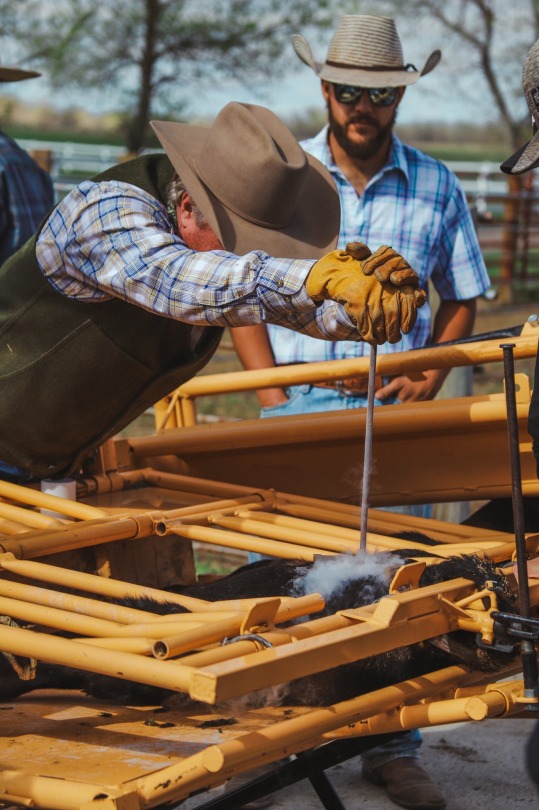
Trust your neighbor but brand your cattle.
@ misslerouxx Insta
#ranching#ranch hand#ranch life#branding#cattle#cattlemen#ranch photography#cattlebranding#western photography#stomping grounds#horse back riding#colorado rocky mountains#Rocky Mountains
3 notes
·
View notes
Text
From the Archives: Good Luck

When you start looking at Ozark folkways you’ll see pretty quickly that most of the charms and so called “superstitions” are aimed at luck and love. Luck, as we’ll see in many of the examples below, doesn’t necessarily pertain to worldly goods or money, but to the health of the land, the home, and the family. Here are some examples of luck charms, signs, and omens from Vance Randolph’s Ozark Magic and Folklore:
“A button received as a gift is always lucky, no matter what the color. Years ago, many an Ozark girl collected buttons from her friends and strung them together into a sort of necklace called a charm string. A charm string not only brought good fortune to the owner but also served as a sort of memory book for women who could not read one button recalled a beloved aunt, another a friend’s wedding, still another a dance or a quilting party or an apple-peelin’ or some other pleasant occasion. Nancy Clemens, of Springfield, Missouri, says that the craze for charm strings once reached a point in Douglas county, Missouri, where girls had to borrow pins to fasten their dresses before they could go home from a party. May Stafford Hilburn remarks that ‘each donor of a choice button came under the charm, and nothing could break the friendship between that person and the owner of the charm string.'”
“Many hillfolk think that the man who finds a horseshoe with the closed end toward him will do well to ‘leave it lay.’ If the open end is toward the finder, he sometimes spits on it and throws it over his left shoulder, a procedure which is supposed to bring good fortune. Or he may place it in a tree or on a fence, saying: ‘Hang thar, all my bad luck!’ In this case, whoever touches the hanging horseshoe falls heir to the misfortune of the man who placed it there. In some parts of the Ozarks one sees dozens of bad-luck horseshoes hanging in trees along the roads, but no real old-timer will touch one of them for love or money. Near the village of Day, Missouri, I have noticed that even my old friend ‘Doc’ Keithley walks wide of these horseshoes, although he is scornful of most taboos and superstitions.”
“An empty hornets’ nest is hung up in the loft of nearly every old-time mountain cabin, and I have seen such a nest tied to the rafters of a new house that had not yet been occupied; some people say that this brings good fortune to the whole household, particularly in connection with childbirth and other sexual matters.”
“If you find your initials in spider webs near the door of a new home, it is a sign that you will be lucky as long as you live there.”
“To find a dead crow in the road is always lucky, but a dead ‘carr’n crow’ is a sign of superlative good fortune.”
“Most hillfolk seem to think that the presence of a feather crown in one’s pillow means good fortune here or hereafter, but there are some who believe they are death signs, the work of the Devil.”
“Barn swallows are supposed to bring good luck to cattlemen, and it is said that a barn in which swallows are nesting will never be struck by lightning.”
“When a woman burns light bread, so that the crust is black, it is a sign that she will fly into a rage before the day is over. The person who eats this blackened bread will have good luck, however, and among other blessings will never be troubled by intestinal worms.”
“Many of the old settlers say that it is good luck to find a rock with a hole in it, but that such a stone found in running water is superlucky. At several homes in the Ozarks I have seen little boxes containing stones with holes in them, placed under the porch or the wooden doorstep. Near Marvel Cave, in Taney county, Missouri, the Lynch sisters who own the cavern used to have a lot of these stones strung on wire; when Nancy Clemens and I visited the place in 1936, Miss Miriam Lynch took down one of these wires and gravely presented each of us with a lucky stone. Some say that lucky stones keep off witches and evil spirits; others tie one of the stones to a bedpost in the belief that it somehow prevents nightmare. Near Harrison, Arkansas, children are told that it is good luck to find a round stone with a hole in it, but that such a stone must be thrown away at once and never carried in the pocket.”
“A few hillfolk say that it is good luck to see a white cat on the road; there is some difference of opinion about this, but everybody agrees that it is a very bad sign when a black cat crosses ahead of a traveler.”
“Country boys often leave one fish of a large catch hanging in a tree near the fishing hole. ‘Oh just for the birds,’ a boy answered rather sheepishly when I asked him why this was done. The old-timers say that it is supposed to bring good luck next time.”
“A man in Fort Smith, Arkansas, told me that his father placed the entrails of a big horned owl over the door, to keep witches away. And Otto Ernest Rayburn tells of a man on trial for hog-stealing who wore ‘the dried gizzard of a hoot-owl tied round his neck for good luck.'”
“A dream of death is good luck if the dream comes at night and usually signifies a wedding, but to fall asleep in the daytime and dream of death is very unfortunate.”
“It is good luck to dream of pigeons or doves, and usually means that a fortunate love affair is just around the corner.”
#ozarks#traditional witchcraft#witchcraft#folk magic#Ozark Folklore#ozark folk magic#ozark folkways#ozark folk medicine#folklore#traditional healing#traditional medicine#ozark healing traditions
69 notes
·
View notes
Link
Excerpt from this New York Times Op-Ed:
Both the B.L.M. and the Forest Service operate with a congressional mandate for what’s called “multiple use” management. On paper, multiple use means exploiting the land for its resources in a way that maintains ecosystem health.
In practice, it long amounted to what William O. Douglas, a backpacker, outdoorsman and the longest-serving Supreme Court justice, described in 1961 as “semantics for making cattlemen, sheepmen, lumbermen, miners the main beneficiaries.”
Regulation has improved somewhat since that time, thanks to sweeping environmental laws passed in the 1960s and ’70s. The Federal Land Policy and Management Act of 1976 stipulated that “scientific, scenic, historical, ecological, environmental, air and atmospheric, water resource and archaeological values” and “the long-term needs of future generations” must be taken in account in managing those expanses. But the land still suffers, as those laws too often are ignored or soft-pedaled.
Journey across the B.L.M. and Forest Service domain today and you’ll find no shortage of uses that look more like abuses. Oil and gas fields blight the deserts and steppe. Coal, copper, silver and gold mines stab into cliffs and mountains. Forests are felled for timber interests, grasslands are overgrazed for the benefit of cattlemen. The result is ecological impoverishment, biotic simplification and a widespread collapse of biodiversity.
Regulation has improved somewhat since that time, thanks to sweeping environmental laws passed in the 1960s and ’70s. The Federal Land Policy and Management Act of 1976 stipulated that “scientific, scenic, historical, ecological, environmental, air and atmospheric, water resource and archaeological values” and “the long-term needs of future generations” must be taken in account in managing those expanses. But the land still suffers, as those laws too often are ignored or soft-pedaled.
11 notes
·
View notes
Text
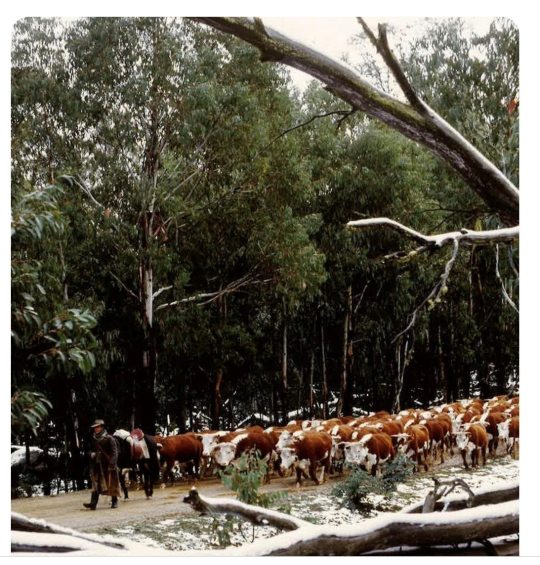
Leading the mob down out of the Dargo High Plains, early'80's
photo sourced: Mountain Cattlemen's Association of Victoria
11 notes
·
View notes
Text
On Seeing, A Journal. #278 Andrew Moore, "Dirt Meridian,” a book review.
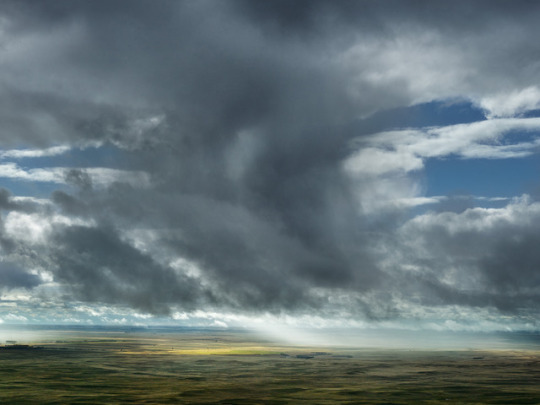
Sun Through Rain. ©Andrew Moore
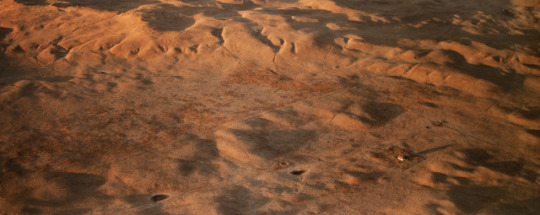
Schoolhouse, China Pasture. ©Andrew Moore
I receive, daily, the internationally informative photography news site

The Eye of Photography from the former editor-in-chief of French Photo Magazine and now editor-in-chief of The Eye of Photography, Jean-Jacques Naudet. This daily posting is phenomenally valuable, covering all sorts of photography events, portfolios of photographers throughout the world, gallery shows, museum exhibitions, etc.
The site is free, though as an aside they can use financial help for their service. Apart from having contributed features from time to time, I have no affiliation with them, I’m only interested in seeing the on-going success of something that publishes so much information and imagery every day.
Other important sources include AtEdge and Graphis.
Each of these open up to a wide world of brilliant photographers, designers, and other creatives.
A recent post contained an article about the The Yancy Richardson Gallery in New York City. The images of Andrew Moore who is represented by the gallery particularly caught my eye. I went to his site ((http://www.andrewlmoore.com)) and was so moved by his body of work that I bought his recent book,
"Dirt Meridian.”
I do that, buy and collect photography books. Along with the internet, books are my major source of self-education. I am well aware that if I am to grow in this visual art, it’s imperative that I study, continually, tenaciously. It’s essential to gain, maintain and expand a vast visual data bank if one desires to create unique, original and exciting work. For photography, one needs to look, study, and look even more, reviewing and surveying everything available in galleries, web sites, periodicals, museums, presentations and, yes, books. Our brains are such that images drop out; constant replenishment is needed for any sort of positive development, success, and even survival in this challenging art. It’s essential to recognize what’s been done before in order to avoid repetition. Knowing what hasn’t been done, or done well enough, comes when one has seen – and keeps seeing -- a vast range of imagery.
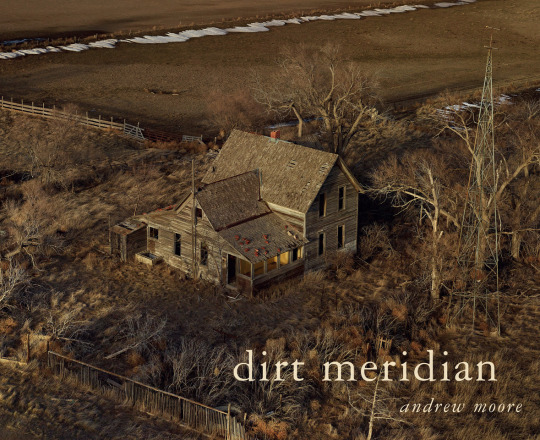
When “Dirt Meridian” arrived, I opened it and couldn’t put it down, studying every image. And, as I always do with a new book of photographs, I left it out, opened, on a counter I pass daily, so that I could look at it again and again and imprint the images in my memory.
This is not the kind of photography I endeavor to create in the controlled environment of a studio (or a pool, my particular kind of studio). Moore’s work is done outdoors, in this case in the vast, almost empty space of the great plains of middle America. What he shows us are sand hills and sky and weather and cattle. And the Badlands and old abandoned barns and buffalo and meadows and creeks, windmills and wildlife. He also shows the determined struggle of the human spirit against the toughest elements, and the effect of those on deserted homesteads.
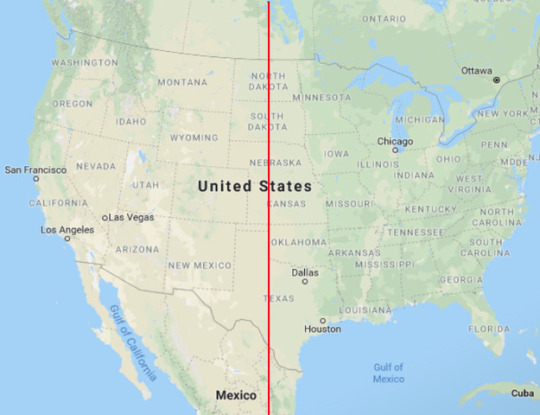
America, its 100th meridian.
Moore’s epic visions of the vast treeless space in the 100th meridian, cutting through North and South Dakota, Nebraska, Kansas, Oklahoma, and Texas, are all about space -- empty sprawling and seemingly infinite space. The images are intoxicating, filled with magnificent beauty in the loneliness that is the trackless expanse of seemingly endless land. From his Acknowledgement: “…the land’s beauty lies in its vast and sublime emptiness."
I wrote to Moore and learned, happily, that his NYC studio/office is located only a few blocks from mine. So, I invited him for lunch and an in-person review of his magnificent photographs.
Working on this book project, he spent weeks at a time on many trips from the East, met many individuals and recorded their stories, histories, lives. Each photograph is accompanied by text containing fascinating information which provides a rich understanding of the work.
Moore made many of the photographs from a Cessna 180 single-engine plane flown by Doug Dean. They attached his medium format digital camera to one of the plane’s wing struts, using a screen and remote control from the passenger seat.
They flew low, yielding a unique perspective. This technique is one important reason why the images look so different from photographs of this area I’ve seen before. He spoke of the emptiness as a spiritual reservoir, a spiritual landscape. He wrote in the Acknowledgements, “the intimate seemed conjoined to the infinite."
During the project he moved from north to south, contrasting open spaces with cluttered, claustrophobic interiors, rich with poor, immigrants and native born, industrial scenes with mythic landscapes, all of which he explained was a metaphor for the sense of possibility, of hope that tomorrow will be a better day.
In the book his pilot wrote, “I hope you take pause, if only for a moment, to consider the story of this land, where second chances are few, and how the decisions we make today will impact the generations to follow."
Moore allowed me to choose images I personally wished to use for this review.
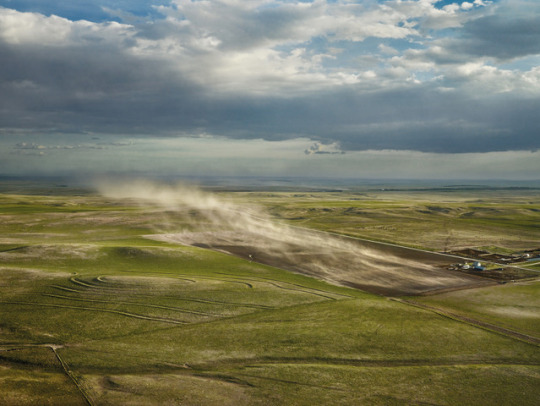
Storm Blow. ©Andrew Moore
From the book: “Sheridan County, Nebraska. These dry, fallow lands and terraces lie to the southeast of Clinton. The wind coming out of the north was blowing at over 70 mph. When choosing the angle approach to a subject, Doug Dean piloted us, if possible, into a headwind, since that slowed the plane down and allowed a bit more time for picture making. On this day we had little choice but to let a powerful tailwind take us on a Nantucket sleigh ride if we wanted to catch this billowing cloud of white dirt."
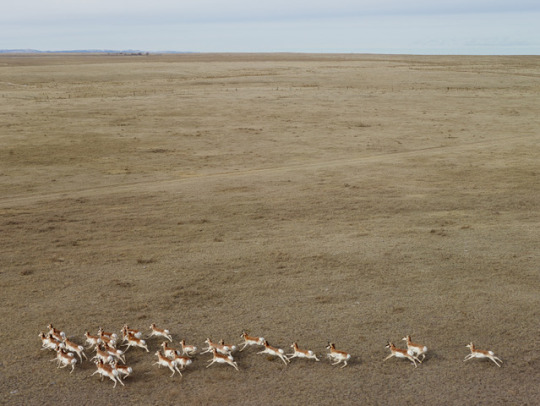
Pronghorn Antelope. ©Andrew Moore
From the book: “A herd of the wild antelope, which in wintertime can number into the hundreds, roams the high plains that stretch toward the Big Horn Mountains in the background. Early pioneer cattlemen noticed that the native grass animals roaming this area tasted particularly good, and to this day Niobrara County grass has become famous among livestock buyers for the finish it gives cattle.”
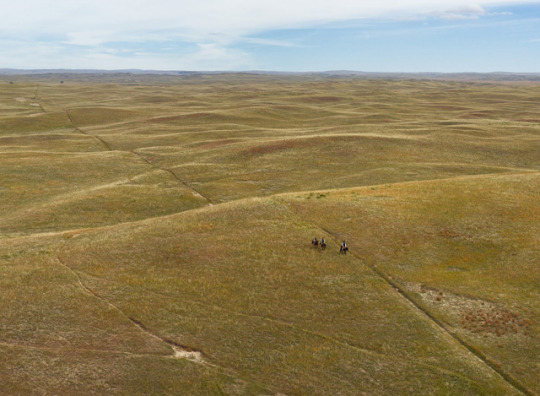
Riding Fence. ©Andrew Moore
From the book: “Sheridan County, Nebraska, 2013. Heidi and Brock Terrell and their son Royal (led by their red heeler) ride fence along their land in Sheridan County. They not only raise both cattle and sheep but they also farm soybeans and sugar beets. Heidi is a sixth generation descendant of Jules Sandoz, among the earliest homesteaders in the area. Better known as ‘Old Jules,’ legendary for his cussedness and his justly famous tenacity, he was immortalized in the biography of the same name written in 1935 by daughter Mari Sandoz.”
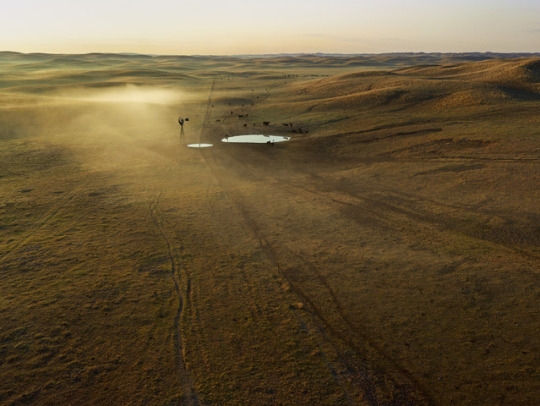
First Light. ©Andrew Moore
From the book: "Cherry County, Nebraska, 2013. Cattle and heron share a drink at the tank in the residual morning fog. Much of the success of cattle ranching in the Sandhills is due to the shallow reach down to the Ogallala Aquifer. In some places it's only six feet to water, so one can easily and cheaply put down a windmill in order to water livestock anywhere in the vastness of this terrain. (There are many sub-irrigated meadows that provide hay at the driest times.) The hilly landscape provides the herd with protection from the wind and snow. However, the quality of the grass is not as good as on hard soil land, so it can still take 20 to 30 acres to support just one cow/calf pair."

Round Up Number 2. ©Andrew Moore
From the book: “McKenzie County, North Dakota, 2005. Branding day at the Hepper Ranch outside the town of Keene. In the shadows of the Blue Buttes, amidst lush May grass, family, friends, and neighbors (and several dogs) help round up this herd of 300 cow/calf pairs. The large crew included five heelers, six sets of floppers, branders, vaccinators, and iron tenders. The older more experienced cowboys do the actual branding while the younger folks who wrestle the calves are known as floppers.”
In the book’s introduction, Kent Haruf wrote, “These are wonderful photographs, clear, and evocative, unsentimental, they seem to understand the sacredness of the country. They suggest its holiness."
Howard Schatz, November, 2018.
254 notes
·
View notes
Text
THE GEEBUNG POLO CLUB
The 30th annual Geebung Polo match was held on Easter Sunday at Victoria's largest cattle farm, Cobungra Station, located between Omeo and Dinner Plain Alpine Village. The annual event sees mountain cattlemen from the Geebung take on the "Cuff and Collar" team from the city. The annual event differs from traditional polocrosse as apparently the game played at Cobungra has no rules, although I did hear a few points were scored when the ball was hit between a couple of snow gums at each end of the paddock. Geebung won the game this year, captained by Ken Connley of Hinnomunjie.
THE GEEBUNG POLO CLUB
by A.B. “Banjo” Paterson
It was somewhere up the country in a land of rock and scrub,
That they formed an institution called the Geebung Polo Club.
They were long and wiry natives of the rugged mountainside,
And the horse was never saddled that the Geebungs couldn’t ride;
But their style of playing polo was irregular and rash –
They had mighty little science, but a mighty lot of dash:
And they played on mountain ponies that were muscular and strong,
Though their coats were quite unpolished, and their manes and tails were long.
And they used to train those ponies wheeling cattle in the scrub:
They were demons, were the members of the Geebung Polo Club.
It was somewhere down the country, in a city’s smoke and steam,
That a polo club existed, called the Cuff and Collar Team.
As a social institution ’twas a marvellous success,
For the members were distinguished by exclusiveness and dress.
They had natty little ponies that were nice, and smooth, and sleek,
For their cultivated owners only rode ’em once a week.
So they started up the country in pursuit of sport and fame,
For they meant to show the Geebungs how they ought to play the game;
And they took their valets with them – just to give their boots a rub
Ere they started operations on the Geebung Polo Club.
Now my readers can imagine how the contest ebbed and flowed,
When the Geebung boys got going it was time to clear the road;
And the game was so terrific that ere half the time was gone
A spectator’s leg was broken – just from merely looking on.
For they waddied one another till the plain was strewn with dead,
While the score was kept so even that they neither got ahead.
And the Cuff and Collar captain, when he tumbled off to die,
Was the last surviving player – so the game was called a tie.
Then the captain of the Geebungs raised him slowly from the ground,
Though his wounds were mostly mortal, yet he fiercely gazed around;
There was no one to oppose him – all the rest were in a trance,
So he scrambled on his pony for his last expiring chance,
For he meant to make an effort to get victory to his side;
So he struck at goal – and missed it – then he tumbled off and died.
By the old Campaspe River, where the breezes shake the grass,
There’s a row of little gravestones that the stockmen never pass,
For they bear a crude inscription saying, “Stranger, drop a tear,
For the Cuff and Collar players and the Geebung boys lie here.”
And on misty moonlit evenings, while the dingoes howl around,
You can see their shadows flitting down that phantom polo ground;
You can hear the loud collisions as the flying players meet,
And the rattle of the mallets, and the rush of ponies’ feet,
Till the terrified spectator rides like blazes to the pub –
He’s been haunted by the spectres of the Geebung Polo Club
5 notes
·
View notes
Text
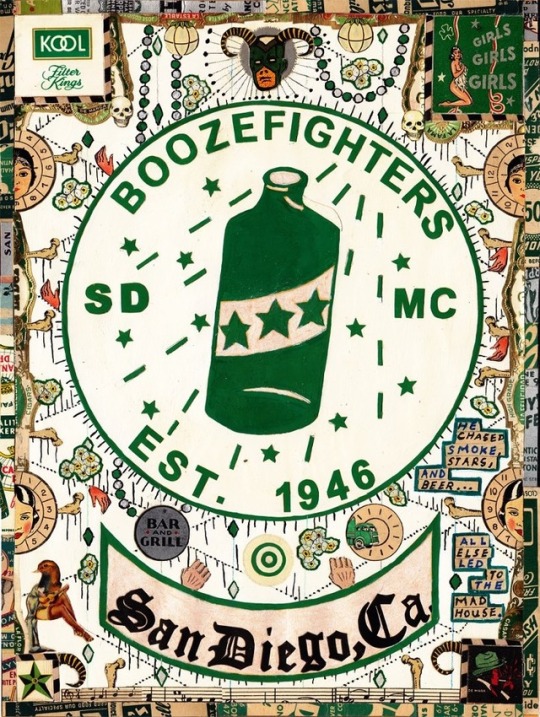
***Art work and words by my good friend Mr Tony Fitzpatrick. Thank you for your amazing art and kind words about the Boozefighters.
“Johnny…What are you rebelling against?”
“Whatya’ got?”
–Marlon Brando
The Wild Ones
There has never been a better recruiting tool for motorcycle clubs than this movie. It is based on The Boozefighters, one of the first-ever motorcycle clubs in Southern California. It’s actually based on the Hollister, California “riots” in 1947, a riot so laughably tame it actually amounted to little more than six or seven Boozefighters being arrested for drunk and disorderly for drinking and racing their big American bikes in the streets of the small town, and a remarkably-pussy police force (only seven cops, two of them near retirement–they almost wet themselves) over a summer weekend that scared the shit out of the locals, who’d evidently never seen anyone piss in the street before.
It was not more dangerous than any small town parade with a few rowdy drunks thrown in. Well, a reporter got a hold of it on a slow news day and decided to paint it as the end-all of civilization. The tale of a marauding gang of motorcycle hoodlums proved to be catnip for the Hollywood imagination as well. In one of the string of star-making roles Marlon Brando had in the mid-50s, none produced more juvenile delinquents than the The Wild Ones.
Along with Lee Marvin, who played “Chino”, (loosely based on Boozefighters founding member Wino Willie Forkner) Brando made it downright sexy to be a mouthy asshole on a motorcycle. Soon there were bike clubs all over California and the rest of the country, as well. But nowhere did they have the lifestyle currency that they had in California. Lots and lots of road, through mountains, next to the sea. . .from San Diego to Big Sur, there was lots of American landscape to get lost in and to marvel at from a huge, speeding American Motorcycle.
It’s important to remember that clubs like the Boozefighters, the Flying Tigers and the Hells Angels were formed in the crucible of the second World War. The effects of fighting the war cannot be underestimated in the nihilism that came to characterize some of the nastier outlaw clubs. A great many young men went overseas fully expecting not to return–my own father did.
Upon surviving; a new, more fatalistic view of the world took hold among many veterans and colored their view of the world and their place in it for the rest of their lives.
It is also important to take a longer view and realize this was always the case as it was with William Quantrill’s Raiders, after the Civil War. The immense push westward, by nomadic groups of farmers, cattlemen, prospectors and snake oil salesmen, men who needed to get lost in the bounty and promise of America, hoped to hell all of the hopeful hyperbole was true.
“Go West, young man,” seemed a mantra as well as an idyllic destination.
When “Wino Willie” Forkner returned from World War II, he knew he wasn’t ready to settle into a job settle into a middle-class life and become a regular taxpayer. It didn’t make sense to go from warfare one week to squaresville the next. Warfare had awakened the restless spirit in a great many of these returning vets, as well as the fact that the hearing damage a great many air men had incurred, had inadvertently disqualified them from potential jobs in the still nascent aerospace industry.
Some guys became astronauts and some guys became Boozefighters, Hells Angels, and Gypsy Jokers, and took the endless American road for their home. They went to the Redwing store and bought heavy-buckled engineers boots and strapped on steel.
Harleys, Nortons and Indians tore ass across the California landscape just because they could and nobody was going to tell them different.
This was the birth of the 1%ers; the one percent that didn’t fit in to polite society and didn’t fucking want to.
The Boozefighters never became an outlaw club. In fact, these days they spend a great deal of their time doing good deeds for kids and returning veterans.
They, like the Angels, are resolutely patriotic–a great many of them former soldiers, sailors, and air men. The clubs are very often structured like a military unit. There is also a great love for beer in this club. In fact, they describe themselves as, “a drinking club with a motorcycle problem.”
There are now Boozefighter chapters all over the U.S. and the U.K., as well as Japan. While they are not a criminal club , they are still not a bunch to fuck around with. They don’t back up from confrontation and there are always a lot of them.
There is an old saying among bike clubs that is observed when they are making a public appearance as a club, “Always bring a crowd.”
And they do.
6 notes
·
View notes
Photo
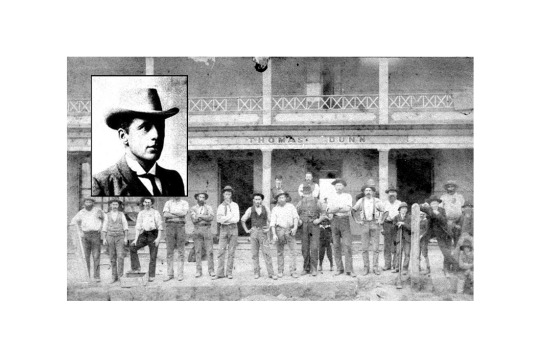
LEGENDARY mountain horseman, 29-year-old Jimmy Kiss opened Bega’s Royal Hotel (pictured) on the NSW South Coast in 1873. Jimmy was a well-known Snowy Mountain’s rider, who was “never known to be unseated by any bucking horse”. Jimmy was a splendid rider, known to throw his hat or stock whip to the ground, and, galloping past, stoop from his horse and pick up either article. Reportedly, Jimmy was one of the ‘mountain men’ who inspired Banjo Patterson (pictured inset) to write ‘The Man from Snowy River’. While Patterson acknowledged his poem was a work of fiction, he conceded it was based on a number of mountain cattlemen, who he had met or was told about while visiting the Snowy Mountains. Read the story of Jimmy Kiss and Bega’s Royal Hotel at The Time Gents website: (via Bega's Royal Hotel was established by legendary mountain horseman, Jimmy Kiss)
0 notes
Text
Elise Cooper Interviews Adina Senft
The Amish Cowboy by Adina Senft brings to life the Amish community within the Montana setting. It is a ‘what if’ story. What if there were Amish who became cattle ranchers, and what if the hero and heroine had never had a chance reunion?
Daniel Miller is the oldest of six siblings. He is a rugged Amish cowboy who manages roundups, takes care of the land, helps to raise cattle, and expertly rides horses. He is more like the foreman of the family Circle M Ranch in northwestern Montana.
But at the age of twenty-eight he is viewed as a male spinster because he has yet to get married. His heart was broken ten years earlier when the love of his life, Lovina Lapp said no to his marriage proposal. Instead, she married another man who was recently killed in a hunting accident. To overcome their grief, she accepted an invitation to take her eight-year-old son Joel and visit the national parks. But because the van they were in broke down she and Joel were now stranded in Montana with Daniel and his family. Because Joel was so enthusiastic, she agreed to go with the Millers and their neighbors to bring down the cattle before winter came. But due to weather conditions, money restraints, and other circumstances she and Joel stayed much more then they planned. It became obvious that both Daniel and Lovina still have feelings for each other, but would they allow the walls they built around themselves to fall.
Although there might have some liberties taken, the way the story was presented seemed very plausible that the Amish could be cowboys. Readers will take a journey with the characters and learn about Montana. They will also feel a part of the Miller family and will root for them to have a happy ending.
Elise Cooper: What about the series?
Adina Senft: This is book one of six. There are six siblings in the Miller family and each sibling gets their own book. Even though it is a different hero/heroine it is the same family where I weave them into all six books. It will be a happy medium between one sentence telling readers about the rest of the family and a few chapters. It is like an Amish family experience to put all the family members in.
EC: Idea for the story?
AS: I was looking for what has not been done with Amish fiction. I thought about a series set in Montana. This past June my husband and I went there to visit the Amish community. We did feet on the ground research. Plus, a friend of mine, the captain of the firehouse where I live is President of the California cattlemen’s association. He invited me to come to his ranch and watch the roundup. The idea was born between him, the Amish community, and it seemed believable and possible that the Amish could possibly raise beef cows in Montana. The Circle M brand is on the cover.
EC: Amish and horses?
AS: For them horses are for work, not pleasure. Cattle ranchers would use them for work. A cutting horse is one of the most finely tooled instruments I had ever seen. When I was on the California ranch, within hours the calves were separated from the mothers. It was like watching a ballet where everyone knew their steps. When we were in Montana, the Amish came to the school auction on buggies, bicycles, and the occasional riding horse.
EC: Why the Montana setting?
AS: Only a few Amish stories are set here. Plus, I used to live in Alberta Canada, and I knew the ranchers are about seven miles north of the Amish community in Montana. The weather, the way people worked with the land, the short period of time of the growing season, and the terrain were all familiar to me. Montana winters are very long and brutal. I had to move the location in Montana because the Amish community lives in the mountains, which does not lend itself to ranching. I have not met an Amish cowboy, but I think they are possible.
EC: How would you describe Daniel?
AS: The eldest son of a large close-knit family. Very responsible and a nice-looking man. He has a natural command in being the oldest brother. Now at twenty-eight he is still not married because he has been carrying a torch for Lovina for ten years. He is honest, compassionate, patient, and gentle.
EC: How would you describe Lovina?
AS: She had a childhood backstory of never being wanted and never able to get what she wanted. She lost her ability to make connections with people. She was never treated with joy and welcome. Now she is a good mother, very protective, smart, resourceful, but still fearful, vulnerable. She used to be a closed defensive person, but now is opening up.
EC: Why the visit to the twelve national parks?
AS: I had the idea from an Amish girl who told me she and her buddies went on a circuit of the national parks. Lovina turned it into an educational experience as well as a recreational one. It was also a grief recovery trip since she lost her husband, and her son Joel lost his father.
EC: What about the relationship?
AS: She turned down Daniel’s initial proposal of marriage because she never saw herself as worthy. He had hurt feelings. She is confused about her emotions. They are trying to protect themselves from each other, yet the memories of their time together keep creeping in. They need to find trust in each other. She was fearful and he was hurt. He unconsciously compared every girl he met to Lovina, and they never added up. No matter how perfect another woman can be, there is only going to be Lovina for him, even if he does not realize it yet.
EC: In this story, are the Amish modernized?
AS: They used cell phones, the Internet, and horses. The cell phones and the Internet is right from my research, which they use for business. Because they are spaced so far apart with severe weather, cell phones are needed for a matter of safety. In the book, the mother Naomi does keep it in a cookie jar until they go on the roundup. Since they are in harsh weather communities, they are dependent on their neighbors, including the English.
EC: The role of the child, Joel?
AS: He was based on a child I know. He brings people to together through his innocence. He foreshadowed how it could be for Daniel and Lovina. He helps Lovina to connect to the outside and overcome her grief. She notices the setting through his eyes. Joel is curious about the snow, the animals, and the land. At times, he makes her adventurous. He is eight years old, but much older than his years. Joel recognized that the other woman, Susan, was very overbearing and desperate to snare Daniel.
EC: Next book?
AS: The Amish Cowboy’s Baby is currently out. It is the youngest son’s Joshua’s story. He is now a father. The third book is about the very shy twin sister, Rebecca, who is always in the background, and overshadowed by her twin sister. It is titled The Amish Cowboy’s Bride and comes out in May.
THANK YOU!!
0 notes